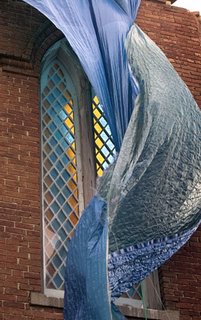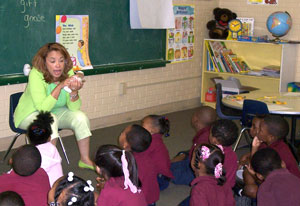HIV and AIDS Campaign: Keep the Promise Action Alert
Mobilize Youth to Hold Governments to their Promises with “Letters to the World”!
A new teaching resource on advocacy and HIV and AIDS is being launched today to encourage young people to:
· voice their opinions
· call on national and world leaders to keep their promises in response to HIV and AIDS.
Produced by the Ecumenical Advocacy Alliance and co-sponsored by UNAIDS, World AIDS Campaign and World Health Organization, the easy-to-use curriculum can be widely used by schools, church groups, and community and faith-based organizations particularly in the run-up to the United Nations review of the Declaration of Commitment on HIV/AIDS, 31 May – 2 June 2006.
Background
In June 2006, government leaders from around the world will be meeting at the United Nations in New York to review promises that they made in 2001 to battle the HIV and AIDS pandemic. This review of that 2001 UNGASS Declaration of Commitment is a chance for young people to voice their opinions and to be heard. The extra pressure from youth will increase the awareness of decision-makers of support for the 2001 commitments and remind them of their responsibility in shaping the future that children will inherit.
In recognition of the significant role young people can play in the response to the HIV pandemic, today, at the World Council of Churches Assembly in Porto Alegre, Brazil, the Ecumenical Advocacy Alliance (EAA) is launching a youth education and advocacy curriculum to encourage discussion and engagement with HIV and AIDS. “Keep the Promise” is a guide for teachers that:
· Introduces basic information about HIV and AIDS (facts, prevention, stigma, testing, treatment, and care).
· Encourages discussion with young people about how HIV and AIDS are affecting the world.
· Examines what governments have pledged to do about the pandemic, the UNGASS review and the importance of the commitments that leaders have and will make.
· Invites them to be effective global citizens by writing a “Letter to the World” about their vision of the response to HIV and AIDS.
· Provides suggestions for follow-up resources, including prayers, songs, activities, websites and more.
The curriculum is currently available in English in print and online for download (see below). French, Portuguese and Spanish versions will be available soon.
The letters from the young people should be sent to the national leaders in the countries who are preparing to go to New York for the review to remind them of the needs and expectations of their constituents in the response to the pandemic.
Classes and groups are also encouraged to send selected letters to the “Keep the Promise – Letters to the World” address in New York (see below) for presentation to key policy makers in advance of the review and a possible exhibition at United Nations headquarters during the review itself.
The curriculum is aimed for ages 11-16 but can be adapted for a younger or older audience. While designed most specifically for advocacy around the UNGASS review, it can be used at any time particularly in holding national leaders accountable to their commitments.
What You Can Do
The Ecumenical Advocacy Alliance strongly encourages everyone to be involved in country- level advocacy by joining the “Letters to the World” campaign – country-level advocacy is even more important than coming to New York for the review itself! to mobilize people for action:
Get a copy of the “Keep the Promise” teacher’s resource. Request a free printed copy of the resource through the online order form, or download the guide directly from the web at: http://www.e-alliance.ch/hiv_curriculum.jsp For more information on the curriculum, email cbordeau@e-alliance.ch
Use the curriculum in your local church or school.
Include people living with HIV or AIDS in preparing the lessons and in community events.
Distribute this action alert or downloaded versions of the curriculum to colleagues and teachers to encourage as many groups as possible to actively engage young people in pressing governments to uphold their commitments.
Send your letters to national leaders. Each class should also select a letter (preferably hand-written) to join others from around the world at the UN in New York. It would be great if you could include a class photo and a note saying how many letters the class has sent. Letters should be addressed to:
Keep the Promise – Letters to the World
211 E. 43rd Street, Room 1100
New York, NY 10017-4707
USA
Use the ideas in the curriculum to publicize the letter-writing project through the media and to raise awareness in the community.
Join the EAA’s UNGASS review listserve for further updates and action alerts. Subscribe by sending an email with your name and organization to cbordeau@e-alliance.ch.
For More Information
Ecumenical Advocacy Alliance http://www.e-alliance.ch/aidssummit.jsp
Web portal for civil society engagement with the UNGASS review: www.ungasshiv.org
For past Action Alerts and Bulletins from the HIV and AIDS Campaign, see http://www.e-alliance.ch/newsletters.jsp
The Ecumenical Advocacy Alliance is a broad international network of churches and Christian organizations cooperating in advocacy on global trade and HIV and AIDS. The Alliance is based in Geneva, Switzerland.
Abingdon Press has released Many Faces, One Church: Cross-Racial and Cross-Cultural Ministry, by Bishop Ernest Lyght, Glory Dharmaraj, PhD., and Jacob Dharmaraj, PhD. The book seeks to bring understanding and engagement in the context, theology, ministry and mission of The United Methodist Church. Written by those who have decades of experience in the local church and in larger missional context of the denomination, the manual offers helpful strategies and practical suggestions to make cross-racial and cross-cultural appointments more effective.
The book is available at Cokesbury Book Stores.
Peace,
Don Hayashi
Don Hayashi
Associate General Secretary
General Commission on Christian Unity and Interreligious Concerns
The United Methodist Church
475 Riverside Drive, Suite 1300
New York, NY 10115
Phone: (212) 749-3553; (800) 653-8936
Fax: (212) 662-7045
E-mail: dhayashi@gccuic-umc.org







